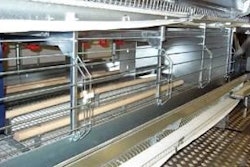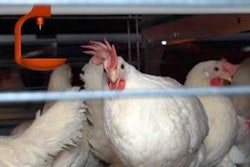
In many instances, maximizing the performance of poultry—whether it be the egg production of layers or the growth rate of broilers and turkeys—provides the best economic return for the poultry grower. Traditionally, poultry rations have been formulated using nutrient standards established to maximize bird performance on a least-cost ration basis.
The doubling, or in some cases tripling, of feed ingredient costs that have occurred over the last few years has highlighted the fact that feeding to produce the most eggs won’t always yield the best economic result for the producer. There are times when ingredient costs are high and egg prices are low where the best feed formulation for your operation may not be the one that maximizes egg output.
Dr. Mark Farmer, senior technical consultant, Ridley Poultry Services, discussed the evolution of feeding poultry at the 2012 Alltech International Symposium. He stated that prior to the 1950s, hens were fed a single diet formulated to ensure maximum output throughout the laying cycle. Phase feeding of poultry started in the 1960s when the rations were changed at particular flock ages during the laying cycle. In the 1970s, rations began to be switched when the birds had consumed a certain number of pounds of feed rather than by the age of the hens. The 1980s and 1990s were the eras of computerized environmental control systems in the laying house, and the 2000s will be known for the implementation of econometric feeding.
Coupling of science and economics
Econometrics is the application of mathematical and statistical techniques to economic data and problems. Econometric models, when coupled with traditional linear programming models used for least-cost feed formulation, allow for the impact of changes in economically important nutrient levels to be evaluated based on their impacts both on projected bird performance and bottom line results. Farmer described how an econometric model for layers can use feed ingredient costs and egg prices input by the producer to estimate economic returns for the flock based on the past performance of hens stored in a database.
Farmer said that the protein and energy components of feed make up approximately 85 percent of feed cost, so Ridley Poultry Services' proprietary econometric model focuses on calorie and individual amino acid levels in the diet. Because feed ingredient costs have increased so greatly, small changes in levels of key nutrients in the diet can have a big impact on profitability.
Improving the bottom line
Econometrics can be used to determine the optimal feed formulation factoring in the response of the birds to the level of nutrients in the diet, feed ingredient costs, predicted level of bird performance and the price of various sizes of eggs. Traditionally, producers have increased nutrients to the level that gives the maximum egg mass output from their hens, and many times this would optimize the bottom line outcome for their operation. But, maximum output from the hens doesn’t always optimize economic returns. In times of low egg prices or high feed ingredient costs, reducing the level of certain costly feed ingredients like lysine or fat may yield a lower egg mass but produce a better bottom line.
Econometric models can help determine the diet that will yield the optimum outcome given current feed ingredient and egg prices. For example, in some circumstances, more money can be made or less money lost by formulating with an amino acid profile that is less than what is required to maximize performance. Because the econometric program lets the producer know when this occurs, the producer has a choice. He can continue to feed for projected maximum egg output, or he can feed for projected optimal returns.
Farmer stated that approximately 25 percent of the hens in the U.S. are currently being fed using econometric models.


















